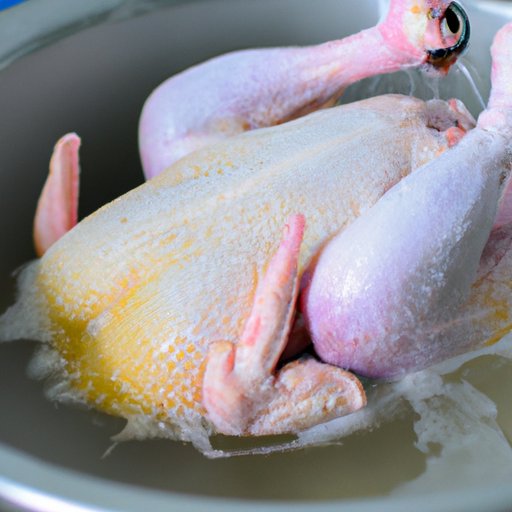
I. Introduction
Do you wash your chicken before cooking it? It’s a question that has been around for centuries, and the answer can vary depending on who you ask. Some people swear that washing chicken is necessary for safety and hygiene, while others insist that it’s actually harmful and can spread bacteria. In this article, we will take a closer look at the practice of washing chicken before cooking, examining its historical context, potential dangers, the science of cooking chicken, cultural practices, and alternative preparation techniques.
II. Historical Context of Washing Chicken
Washing chicken before cooking dates back centuries when farmers would raise their own birds for consumption. Back then, the birds would often be covered in dirt and feathers, making washing them a necessary step. However, nowadays, chicken is processed and inspected under strict regulations before being sold to consumers. The regulations ensure that the chicken is clean, and washing it once again may not be necessary.
The US Department of Agriculture (USDA) Food Safety and Inspection Service (FSIS) recommends against washing chicken before cooking, stressing that it does not make it safer. Instead, they suggest cooking chicken to an internal temperature of 165°F (73.8°C) to ensure that it is safe to eat.
III. Dangers of Washing Chicken
Washing chicken before cooking can actually lead to some health risks. When you wash raw chicken, it can cause the harmful bacteria on the chicken to spread to other surfaces and utensils in the kitchen, such as countertops, utensils, and sinks. This is known as cross-contamination, which can cause food poisoning and other illnesses.
A study by the USDA found that 26% of participants who washed chicken in their sink contaminated their lettuce with bacteria (Campylobacter) compared to 3% of those who did not wash their chicken. This could lead to foodborne illnesses, which can cause serious health consequences, including hospitalization.
IV. The Science of Cooking Chicken and Food Safety
The process of cooking chicken properly is what makes it safe to eat. Cooking chicken to an internal temperature of 165°F (73.8°C) kills harmful bacteria such as salmonella and campylobacter. This is the most effective way to ensure that the chicken is safe to eat.
Food experts suggest that instead of washing your chicken, you should pat it dry with a paper towel to remove any excess moisture before cooking it. This will help to ensure that the chicken is cooked evenly.
V. Cultural Practices in Chicken Preparation
Different cultures have different practices when it comes to preparing chicken. For example, in some Middle Eastern countries, chicken is marinated in spices, yogurt, or lemon juice rather than being washed before cooking. Also, in African and Caribbean countries, chicken is often seasoned with a mixture of spices, such as garlic, ginger, and chili, rather than being washed.
These cultures view washing chicken as unnecessary because it can wash away flavorings and may not be effective in getting rid of bacteria. Instead, marinating or seasoning the chicken is a more flavorful and safer way to prepare it.
VI. Opinions of Top Chefs and Food Bloggers
When it comes to washing chicken, there are varying opinions among top chefs and food bloggers. Some chefs avoid washing chicken because of the risk of cross-contamination, while others wash their chicken and then disinfect their sink and counters afterward.
Food blogger Jessica Gavin explains why she does not wash her chicken before cooking, “I don’t wash chicken because it can contaminate my sink, countertops, and other surfaces, which can result in harmful bacteria spreading to other foods.”
VII. Alternative Chicken Preparation Techniques
There are several alternative chicken preparation techniques that can make up for not washing the chicken. Marinating or brining chicken in a mixture of herbs and spices can help flavor the chicken while also eliminating bacteria. Also, cooking chicken to the recommended temperature of 165°F (73.8°C) can help ensure that the chicken is safe to eat.
VIII. Conclusion
Washing chicken is a debated topic among chefs and home cooks why believe in the safety advantages or disadvantages of doing so. However, the USDA, the food industry, and Food safety experts state that washing chicken is not recommended, and it is better to cook it thoroughly to an internal temperature of 165°F (73.8°C). Cross-contamination when washing chicken is a substantial concern, as it can spread bacteria, leading to food poisoning and illness. It is better to season or marinate chicken before cooking it, or, better still, cook it properly the first time. It is essential to understand the risks involved to make the best-informed decision when it comes to cooking chicken safely.




